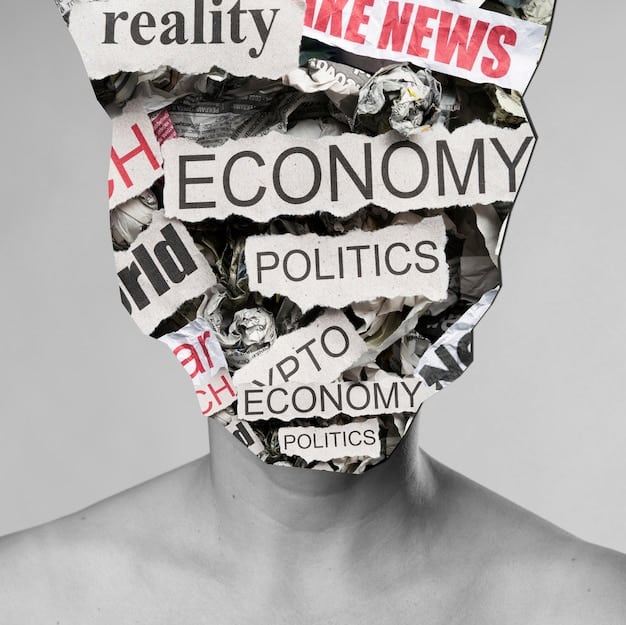The Importance of Fact-Checking and Accuracy in the Age of Misinformation

Fact-checking and accuracy are essential in the age of misinformation to ensure individuals make informed decisions based on reliable information, fostering a more trustworthy and transparent society.
In today’s digital landscape, where information spreads rapidly through social media and online news sources, the importance of fact-checking and accuracy in the age of misinformation cannot be overstated. Protecting oneself from the dangers of fake news has never been more important.
Why Fact-Checking is Crucial
Fact-checking is a fundamental process that involves verifying the accuracy of statements, claims, and information presented as factual. In a world where misinformation can spread like wildfire, understanding why fact-checking is crucial becomes paramount. It ensures that individuals make decisions based on reliable data, fostering a more informed and responsible society.
Protecting Public Discourse
Misinformation erodes public trust in institutions and can lead to social division. Fact-checking helps to maintain the integrity of public discourse by correcting false or misleading information.
Supporting Informed Decision-Making
Whether it’s about health, politics, or economics, accurate information is vital for making informed decisions. Fact-checking ensures that these decisions are based on verified data, not on falsehoods.
- Promotes Accountability: Fact-checking holds individuals and organizations accountable for the information they disseminate.
- Reduces the Spread of Falsehoods: By identifying and correcting false information, fact-checking limits its spread.
- Enhances Critical Thinking: Fact-checking encourages individuals to think critically about the information they consume.
In essence, fact-checking is not just about correcting errors; it’s about safeguarding the foundations of a well-informed and functioning society.
The Dangers of Misinformation
Misinformation, the spread of false or inaccurate information, poses significant dangers to individuals and society. It can influence opinions, incite discord, and even lead to harmful actions. Recognizing these dangers is crucial in understanding the importance of fact-checking and accuracy in the age of misinformation.

Erosion of Trust
Consistent exposure to misinformation can erode trust in media, government, and other institutions. This distrust can lead to cynicism and disengagement from civic life.
Polarization and Division
Misinformation often feeds existing biases and can deepen social and political divisions. It can create echo chambers where people are only exposed to information that confirms their beliefs, leading to increased polarization.
- Health Risks: False health information can lead to dangerous practices and undermine public health efforts.
- Financial Harm: Misleading financial information can lead to poor investment decisions and economic instability.
- Social Unrest: Misinformation can incite violence and social unrest, disrupting peace and stability.
The spread of misinformation is not a victimless crime; it has far-reaching consequences that affect individuals, communities, and the very fabric of society. That’s why the importance of fact-checking and accuracy in the age of misinformation has intensified.
The Role of Technology
Technology plays a dual role in the spread of misinformation. While it enables the rapid dissemination of information, it also provides tools for fact-checking and verification. Harnessing technology effectively is key to mitigating the negative impacts of misinformation.
Social Media Platforms
Social media platforms are both a source and a battleground for misinformation. While they facilitate the quick spread of news, they also struggle to control the spread of false information.
AI and Fact-Checking
Artificial intelligence (AI) can be used to automate some aspects of fact-checking, such as identifying potential misinformation and verifying claims against reliable sources.
However, technology alone cannot solve the problem of misinformation. Human judgment and critical thinking are still essential to evaluate the credibility of information.
How to Spot Fake News
In the digital age, we are bombarded with information from various sources, making it increasingly difficult to distinguish between genuine news and fake news. Learning how to spot fake news is a crucial skill.

Check the Source
Verify the credibility of the source. Look for reputable news organizations with a track record of accurate reporting.
Read Beyond the Headline
Headlines can be sensational or misleading. Read the entire article to get a full understanding of the story.
- Cross-Reference: Check if other reputable news outlets are reporting the same story.
- Look for Evidence: Legitimate news articles provide evidence and sources to support their claims.
- Be Wary of Emotionally Charged Content: Fake news often uses emotional language to manipulate readers.
By following these guidelines, you can become a more discerning consumer of information and reduce the risk of being misled by fake news.
The Responsibility of Media Outlets
Media outlets bear a significant responsibility in ensuring the accuracy of the information they disseminate. Upholding journalistic integrity and committing to fact-checking are essential for maintaining public trust.
Ethical Reporting
Media outlets must adhere to ethical reporting standards, which include verifying facts, providing context, and avoiding sensationalism.
Corrections and Retractions
When errors occur, media outlets should promptly issue corrections and retractions. Transparency in acknowledging and correcting mistakes is crucial for maintaining credibility.
By upholding these principles, media outlets can play a vital role in combating misinformation and promoting a more informed public.
Education and Media Literacy
Education and media literacy are essential tools in the fight against misinformation. Equipping individuals with the skills to critically evaluate information empowers them to make informed decisions and resist the influence of falsehoods.
Critical Thinking Skills
Education should foster critical thinking skills, enabling individuals to question assumptions, evaluate evidence, and form their own judgments.
Media Literacy Programs
Media literacy programs should teach individuals how to analyze media messages, identify bias, and recognize misinformation tactics.
By investing in education and media literacy, societies can build resilience against misinformation and promote a more informed and engaged citizenry.
| Key Element | Brief Description |
|---|---|
| 🔍 Fact-Checking | Verifying the accuracy and legitimacy of information. |
| 📰 Media Literacy | Understanding media and its influence on society. |
| 🌐 Source Credibility | Assessing the reliability of information sources. |
| 🛡️ Combating Misinformation | Efforts to reduce the spread of false information. |
Frequently Asked Questions
▼
Fact-checking ensures that information is accurate and reliable, which is crucial for making informed decisions. It helps prevent the spread of misinformation and promotes a more trustworthy society.
▼
Check the source, read beyond the headline, cross-reference with other reputable outlets, and be wary of emotionally charged content. Look for evidence and reliable sources in the story.
▼
Social media platforms can be both a source and a battleground for misinformation. While they facilitate the quick spread of news, they also struggle to control the spread of false information.
▼
Media literacy is the ability to critically evaluate media messages, identify bias, and recognize misinformation tactics. It empowers individuals to make informed decisions about the information they consume.
▼
Media outlets must adhere to ethical reporting standards, which include verifying facts, providing context, and avoiding sensationalism. They should also issue corrections and retractions when errors occur.
Conclusion
In conclusion, the importance of fact-checking and accuracy in the age of misinformation is paramount. By promoting critical thinking, responsible journalism, and media literacy, we can build a more informed, resilient, and trustworthy society.





